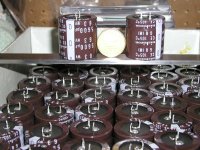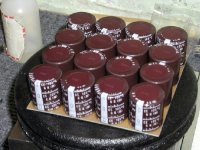Banned
Joined 2002
Coulomb
How fast are these Mepco Caps? I can get the 35kuF -10% 40VDC 60V surge 85ºC for about $8 each, would these be good for any Pass project or is the volt rating too low? Also, which form factor is superior for a low ESR, tall or fat? My guess is tall but fitting them in a case becomes a problem. I am looking for a definitive answer so anyone who knows how these caps will work in a Pass class A power supply, speak up.
How fast are these Mepco Caps? I can get the 35kuF -10% 40VDC 60V surge 85ºC for about $8 each, would these be good for any Pass project or is the volt rating too low? Also, which form factor is superior for a low ESR, tall or fat? My guess is tall but fitting them in a case becomes a problem. I am looking for a definitive answer so anyone who knows how these caps will work in a Pass class A power supply, speak up.
Banned
Joined 2002
would these be good for any Pass project or is the volt rating too low?
The Aelph 5 is powered by a 28 VAC CT transformer. To calculate DCV RMS would go like so.
(28x2)x.7 = 39.2 VDC Assuming Line = 115 VAC
The aelph 3 is powered by 21 VAC CT Transformer, Hence
(21x2)c.7 = 29.4 VDC Assuming Line = 115 VAC
Though the Mepco caps are probably safe for both Amps the Aelph 3 would be your safest bet.
These are old caps and I am not sure how fast they are, as for ESR, these Caps are about the same hieght as the larger caps but it is very narrow in Diameter. I prefer the smaller foot print these Caps offer as well as their responce to line fluctuations. if your on a budget, you take wht you can get.
Banned
Joined 2002
Banned
Joined 2002
Banned
Joined 2002
ok, im still relatively new to this, but i have a question...
for the power supply, you basically have your transformer, then diodes (to change AC to DC voltage), then, caps to smooth out the ripple effect created by the diodes.
now, ive heard and seen just about EVERYTHING done with the caps. some have 2 caps per channel, some have 4, some have like 50! all i know if that the fewer you have, the higher values you need. and if you have more, they are smaller values.
if you are going for quality (cost not an issue), which is better, assuming caps are same quality. would 20 be better than 2?
what is the typical ideal amount of caps used? ive just seen way too many different combos, and little discussion of "why".
for the power supply, you basically have your transformer, then diodes (to change AC to DC voltage), then, caps to smooth out the ripple effect created by the diodes.
now, ive heard and seen just about EVERYTHING done with the caps. some have 2 caps per channel, some have 4, some have like 50! all i know if that the fewer you have, the higher values you need. and if you have more, they are smaller values.
if you are going for quality (cost not an issue), which is better, assuming caps are same quality. would 20 be better than 2?
what is the typical ideal amount of caps used? ive just seen way too many different combos, and little discussion of "why".
Peter Daniel (a.k.a. HPotter)
Is this a fact? I have been told that there is a rapidly diminishing return on parallelizing smaller capacitors to decrease ESR impedence. The other problem with having too many parallel caps is the increasing parasitic inductance. Has anyone in here done a study on the optimal number of caps to put in parallel for optimal ESR?How you like those? Only $1.5 ea. Smaller caps are apparently better sounding.
Coulomb said:I was thinking of making a PCB to mount them all on.
One like that?
Attachments
nania said:Has anyone in here done a study on the optimal number of caps to put in parallel for optimal ESR?
I didn't.
Banned
Joined 2002
Humm i think that i should do the say thing but i still like the idea of 2 x 47,000 caps per block. but 1.25 per cap sound realy decent. hey potter if i buy a pile of them caps exactly like your brown ones canyou send me that pcb design so i can copy it and use it..
Jason
Thanks..
Jason
Thanks..
Banned
Joined 2002
- Status
- Not open for further replies.

